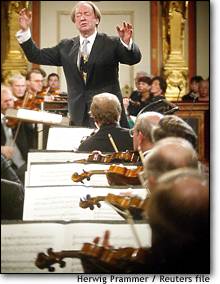
|
|

 |
|
| March 20 — The Vienna Philharmonic’s recently completed visit to seven American cities was one of the longest U.S. tours it has undertaken in decades. The programs included Viennese Waltzes, Alban Berg’s violin concerto and Beethoven’s Pastoral Symphony. The reviews were generally quite negative, especially regarding conductor Nikolaus Harnoncourt. | |||
| The orchestra
wanted to create an all-Austrian image on this tour. American audiences
are all too happy to accept this very stilted view as something
delightfully ‘old world’ and even a bit exotic. |
TIM PAGE OF the Washington Post was unreserved in his acerbic barbs:
“Worse was to come with an interpretation of the “Pastoral” Symphony,
which can charitably be described as dreadful — a performance of such
willful, desiccated perversity that it took my breath away.” And not to be
outdone, John Rockwell, of the New York Times wrote that “... if
19th-century Viennese danced to performances this leaden, our images of
Viennese gaiety need serious revision.” Those who heard Harnoncourt’s New Year’s concert with the Philharmonic already knew something was amiss, and that the orchestra was going to face problems on its U.S. tour well beyond objections to its traditional policies of excluding women and people of color (now window-dressed with the merest tokenism.) ALL-AUSTRIAN IMAGE The Philharmonic wanted to create an all-Austrian image on this tour, and as far as conductors go, Haroncourt was their only choice. American audiences are all too happy to accept this very “echt,” stilted view of the symphony orchestra as something delightfully “old world” and even a bit exotic. The attitude smacks of classical music’s (and white America’s) cultural hubris, lying somewhere between Mozart balls and powdered wigs with a slight touch of Lederhosen. One begins to see why the legendary Philharmonic makes a rare appearance to seven American cities and condescends to them with a program of Viennese waltzes. |
|||
PHILHARMONIC PREOCCUPATIONS |
||||
| A part of
classical music is too ready to accept patriarchal nationalism, which
helps explain why there isn’t more concern about the peculiar gender and
racial ideals that surround the Vienna Philharmonic. |
Ironically, it was exactly the Philharmonic’s preoccupation with
cultural nationalism that caused this tour’s aesthetic downfall. In this
day and age, nationality plays a limited role in the mastery of musical
styles. We saw with vivid clarity that a master of the large symphonic
repertoire like Maazel or Abbado would have served the Vienna Philharmonic
better than an Austrian whose focus is early music. But Americans are an equal partner in this problem. A part of classical music is all too ready to accept this sort of patriarchal nationalism, and it explains why there isn’t more concern about the peculiar gender and racial ideals that surround the Vienna Philharmonic. Given the demographics of the public, patrons and orchestra members, it may be that on an unconscious or even vicarious level, people see the symphony orchestra as a celebration of a sublimated white cultural supremacy. According to musicologist, Pamela Potter, this phenomenon was ironically strengthened exactly by the musicians and musicologists who fled Nazi Germany and became America’s musical teachers. Many were among Germany and Austria’s most dedicated cultural admirers. Their belief in the cultural superiority of their homeland’s music world instilled in Americans a deep admiration and changed its musical focus from France to Germany and Austria. One of the most significant results was a preoccupation with Vienna’s 12-tone music that eventually became a stultifying force among American composers. LOOKING TO THE FUTURE And yes, women have entered symphony orchestras and will even become more common as conductors, but as numerous sociologists have confirmed with other institutions, the entry of women will mean that the entire phenomenon of the symphony orchestra will lose a good deal of its prestige and elite status. But this will only be to its benefit. We will begin to have a much more honest and genuine relationship with it than the current ethos of wine-and-cheese-under-candelabras allows, and classical music will invent new genres more aligned with our own times. A tragedy? Not at all. It will be a measure of our liveliness and creativity. Cultures that grow remain, those that stagnate die. Professionals have long recognized that the elephantine symphony orchestra will evolve into something entirely new, and slowly, the more sophisticated “buffs” are also welcoming the post-symphonic world of music it promises. The Vienna Philharmonic’s tour illustrated that the symphony orchestra is indeed a period instrument, and that they picked a conductor from the wrong era. There are more important qualifications than being Austrian or a white male, and ironically, that understanding is exactly what will help the Philharmonic preserve its tradition. William Osborne is an American composer, musicologist and arts activist who lives in Germany. This article is printed here with his permission. |
|||